The Cambridge History of Japan, Vol. 4: Early Modern Japan
Подождите немного. Документ загружается.

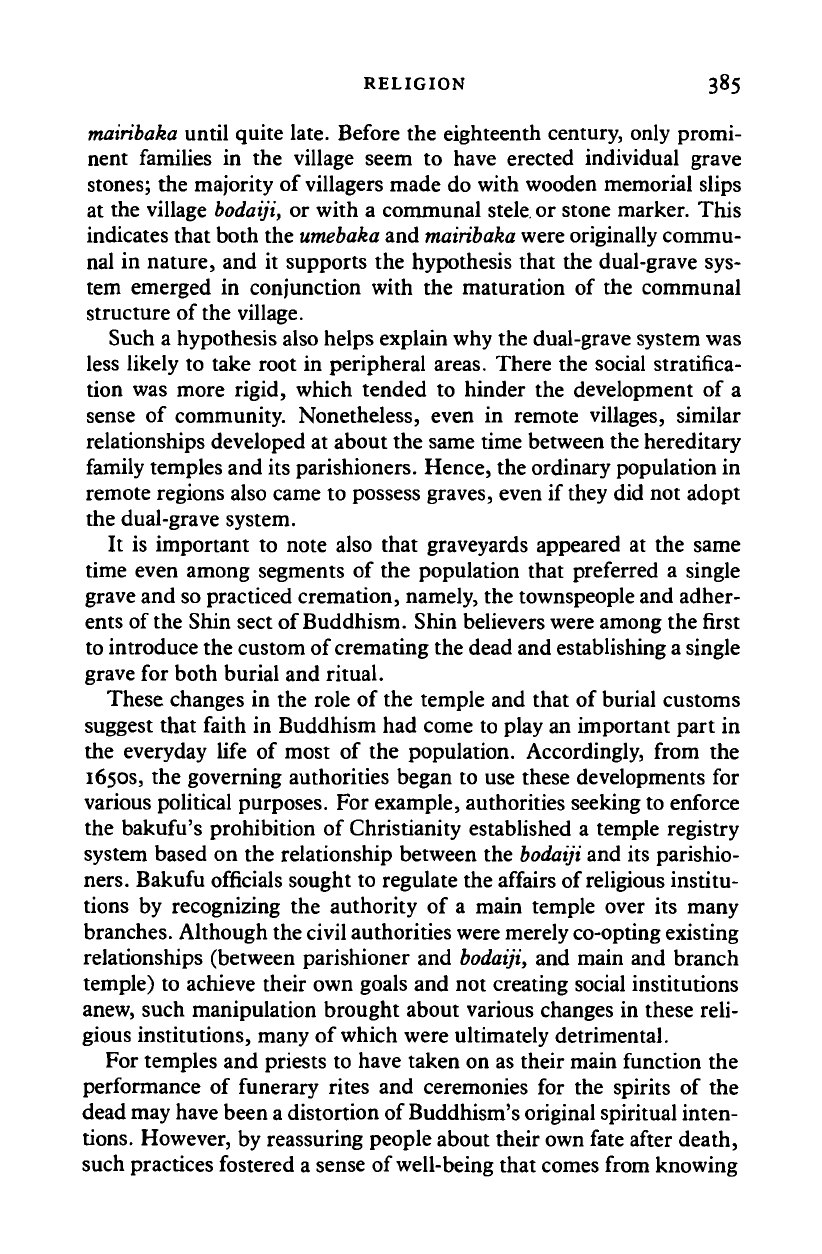
RELIGION 385
mairibaka
until quite late. Before the eighteenth century, only promi-
nent families in the village seem to have erected individual grave
stones; the majority of villagers made do with wooden memorial slips
at the village
bodaiji,
or with a communal
stele,
or stone marker. This
indicates that both the
umebaka
and
mairibaka
were originally commu-
nal in nature, and it supports the hypothesis that the dual-grave sys-
tem emerged in conjunction with the maturation of the communal
structure of the village.
Such a hypothesis also helps explain why the dual-grave system was
less likely to take root in peripheral areas. There the social stratifica-
tion was more rigid, which tended to hinder the development of a
sense of community. Nonetheless, even in remote villages, similar
relationships developed at about the same time between the hereditary
family temples and its parishioners. Hence, the ordinary population in
remote regions also came to possess graves, even if they did not adopt
the dual-grave system.
It is important to note also that graveyards appeared at the same
time even among segments of the population that preferred a single
grave and so practiced cremation, namely, the townspeople and adher-
ents of the Shin sect of Buddhism. Shin believers were among the first
to introduce the custom of cremating the dead and establishing a single
grave for both burial and ritual.
These changes in the role of the temple and that of burial customs
suggest that faith in Buddhism had come to play an important part in
the everyday life of most of the population. Accordingly, from the
1650s, the governing authorities began to use these developments for
various political purposes. For example, authorities seeking to enforce
the bakufu's prohibition of Christianity established a temple registry
system based on the relationship between the
bodaiji
and its parishio-
ners.
Bakufu officials sought to regulate the affairs of religious institu-
tions by recognizing the authority of a main temple over its many
branches. Although the civil authorities were merely co-opting existing
relationships (between parishioner and
bodaiji,
and main and branch
temple) to achieve their own goals and not creating social institutions
anew, such manipulation brought about various changes in these reli-
gious institutions, many of which were ultimately detrimental.
For temples and priests to have taken on as their main function the
performance of funerary rites and ceremonies for the spirits of the
dead may have been a distortion of Buddhism's original spiritual inten-
tions.
However, by reassuring people about their own fate after death,
such practices fostered a sense of well-being that comes from knowing
Cambridge Histories Online © Cambridge University Press, 2008

386 THOUGHT AND RELIGION: I55O-17OO
that one has already been blessed with salvation, a development that
was not without religious benefit.
It is significant as well that the practice of referring to the deceased
as
hotoke
seems to have become common about this time.
12
The use of
the term
hotoke,
which means buddha, indicates that people believed
that the deceased would enter the realm of the Buddha as a result of
the religious ministrations performed b;, the priest on the parishio-
ner's
behalf.
The belief
also
developed that the spirits of the deceased
returned to his or her family home every year during the Bon festival
held in the summer and at the spring and autumn equinoxes, to re-
ceive the religious solace offered by his or her descendants and by
priests engaged for this purpose. The regular performance of these
seasonal religious ceremonies came to be a distinguishing characteris-
tic of Japanese Buddhism.
From the perspective of Buddhist doctrine, it was contradictory to
expect that spirits freed from the bonds of human existence would
periodically return to this world.
13
Yet it was not perceived so because
Buddhist beliefs had fused with the beliefs of traditional ancestor
worship.
14
As a result, the deceased was regarded not simply as a
hotoke
but also as one of the ancestors who protected the house and
preserved intimate ties with its living members. Likewise, the convic-
tion that even after death one could continue to act as a member of the
house offered further reassurance to the living about their own fate
after death. This constellation of beliefs was reinforced by the spread
of the custom of maintaining a Buddhist altar
(butsudan)
in each
house, dating from about the seventeenth century.
15
The butusdan
contained such objects as a Buddhist image and mortuary tablets of
deceased family members, and it acted as the repository of the spirits
of the ancestors (who had become
hotoke).
Thus,
Japanese Buddhism fostered a this-worldly orientation in two
ways:
It did not demand that ordinary believers pursue a particular
religious regimen, which would set them apart from this world, and it
sought to preserve ties with this world after death. The outlook charac-
teristic of Tokugawa Buddhism linked the everyday life and human
12 Aruga Kizaemon, "Hotoke to iu kotoba ni tsuite," in Takeda Choshu, ed., Senzo kuyo, vol. 3
of Soso bosei kenkyu
shusei
(Tokyo: Meicho shuppan, 1979).
13 Hirayama Toshijiro, "Kamidana to butsudan," in Takeda, ed., Senzo kuyo, pp. 229-31.
14 Much research has been done on the fusion of Buddhism and the veneration of ancestors.
Representative works are Yanagita Kunio, Senzo no
hanashi,
vol. 10 of
Teihon Yanagita
Kunio
shu (Tokyo: Chikuma shobo, 1963); Takeda Choshu, Sosen suhai, vol. 8 of Saara sosho
(Kyoto: Heirakuji shoten, 1957); and also Takeda, ed., Senzo kuyo.
15 Hirayama, "Kamidana to butsudan," and Takeda Choshu, "Jibutsudo no hatten to shu-
shuku," in Takeda, ed., Senzo kuyo.
Cambridge Histories Online © Cambridge University Press, 2008
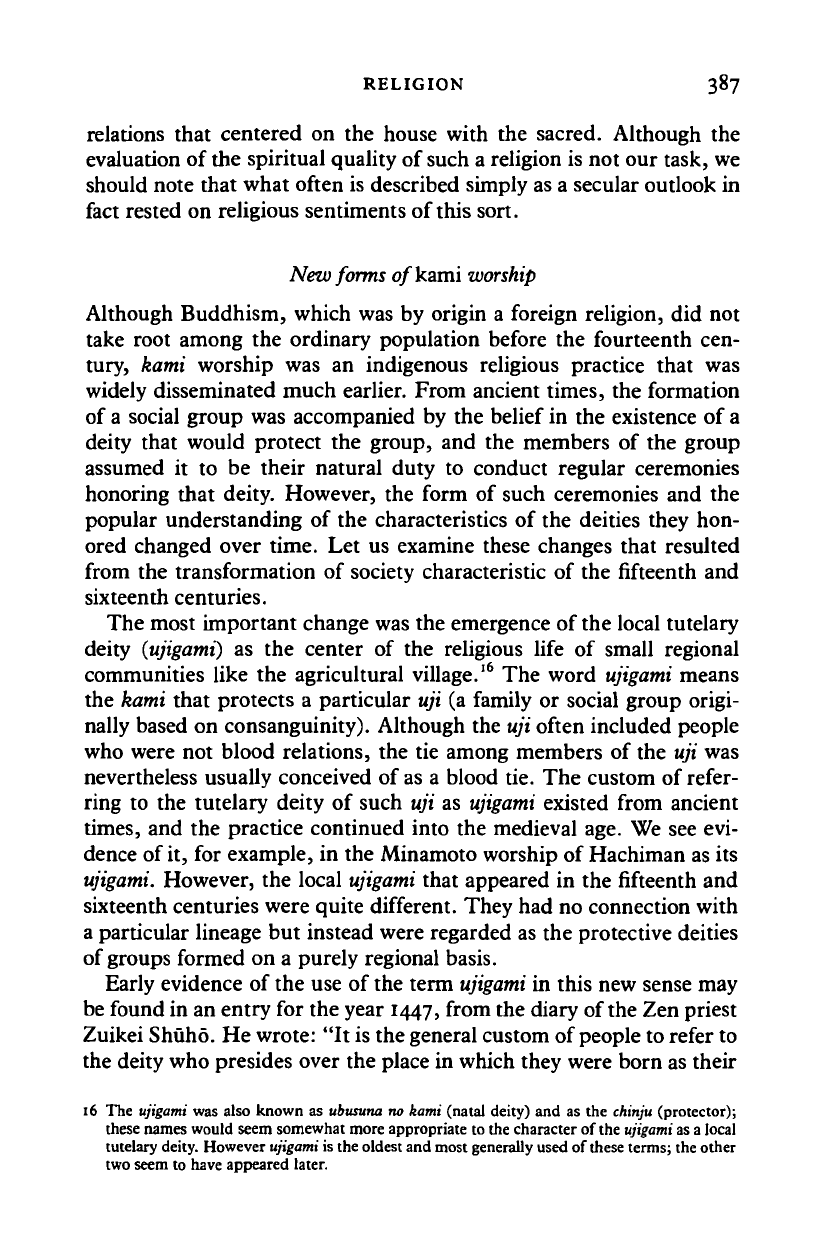
RELIGION 387
relations that centered on the house with the sacred. Although the
evaluation of the spiritual quality of such a religion is not our task, we
should note that what often is described simply as a secular outlook in
fact rested on religious sentiments of this sort.
New forms
o/kami
worship
Although Buddhism, which was by origin a foreign religion, did not
take root among the ordinary population before the fourteenth cen-
tury, kami worship was an indigenous religious practice that was
widely disseminated much earlier. From ancient times, the formation
of a social group was accompanied by the belief in the existence of a
deity that would protect the group, and the members of the group
assumed it to be their natural duty to conduct regular ceremonies
honoring that deity. However, the form of such ceremonies and the
popular understanding of the characteristics of the deities they hon-
ored changed over time. Let us examine these changes that resulted
from the transformation of society characteristic of the fifteenth and
sixteenth centuries.
The most important change was the emergence of the local tutelary
deity
{ujigami)
as the center of the religious life of small regional
communities like the agricultural village.
16
The word
ujigami
means
the kami that protects a particular uji (a family or social group origi-
nally based on consanguinity). Although the uji often included people
who were not blood relations, the tie among members of the uji was
nevertheless usually conceived of as a blood tie. The custom of refer-
ring to the tutelary deity of such uji as
ujigami
existed from ancient
times,
and the practice continued into the medieval age. We see evi-
dence of it, for example, in the Minamoto worship of Hachiman as its
ujigami.
However, the local
ujigami
that appeared in the fifteenth and
sixteenth centuries were quite different. They had no connection with
a particular lineage but instead were regarded as the protective deities
of groups formed on a purely regional basis.
Early evidence of the use of the term
ujigami
in this new sense may
be found in an entry for the year 1447, from the diary of the Zen priest
Zuikei Shuho. He wrote: "It is the general custom of people to refer to
the deity who presides over the place in which they were born as their
16 The ujigami was also known as
ubusuna
no kami (natal deity) and as the
chinju
(protector);
these names would seem somewhat more appropriate to the character of the
ujigami
as a local
tutelary deity. However ujigami is the oldest and most generally used of these terms; the other
two seem to have appeared later.
Cambridge Histories Online © Cambridge University Press, 2008
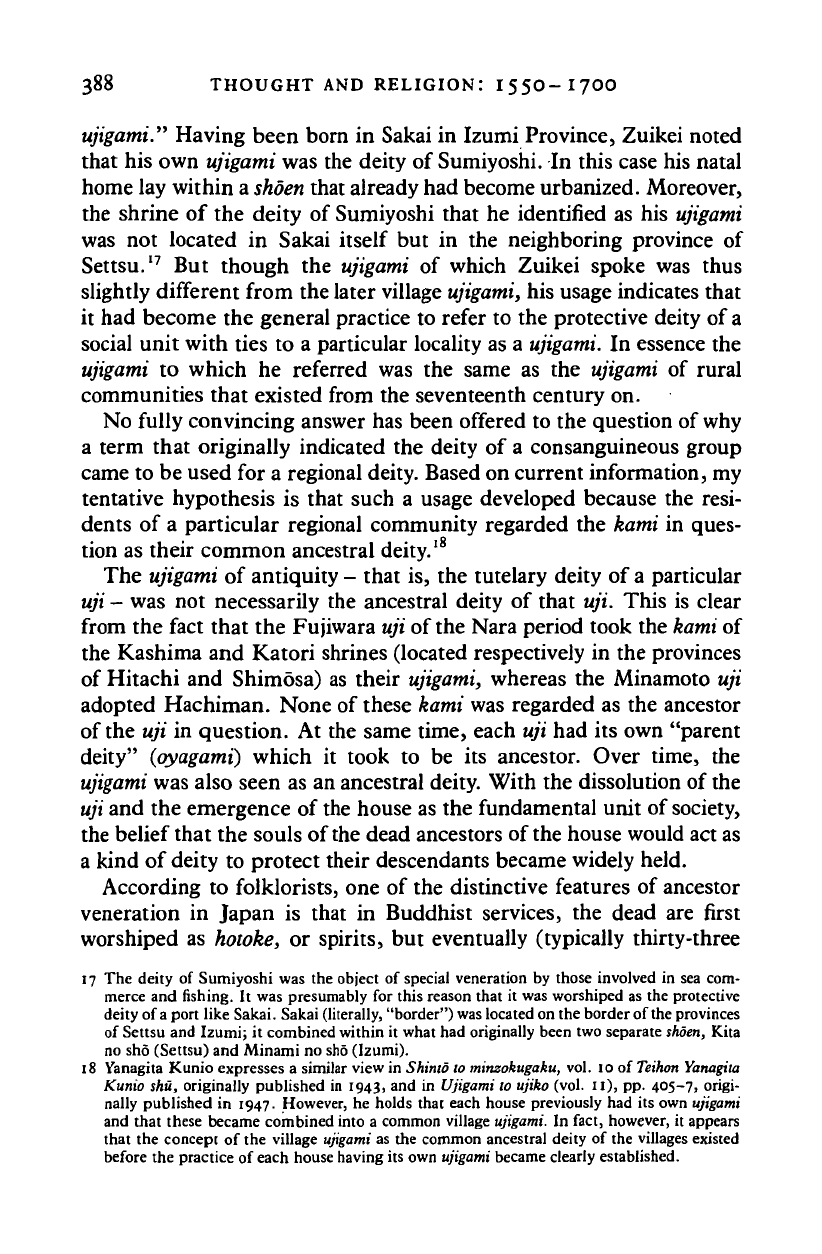
388 THOUGHT AND RELIGION: I55O-I7OO
ujigami." Having been born in Sakai in Izumi Province, Zuikei noted
that his own
ujigami
was the deity of Sumiyoshi. In this case his natal
home lay within a
shorn
that already had become urbanized. Moreover,
the shrine of the deity of Sumiyoshi that he identified as his
ujigami
was not located in Sakai itself but in the neighboring province of
Settsu.
17
But though the ujigami of which Zuikei spoke was thus
slightly different from the later village
ujigami,
his usage indicates that
it had become the general practice to refer to the protective deity of
a
social unit with ties to a particular locality as a
ujigami.
In essence the
ujigami to which he referred was the same as the ujigami of rural
communities that existed from the seventeenth century on.
No fully convincing answer has been offered to the question of why
a term that originally indicated the deity of a consanguineous group
came to be used for a regional deity. Based on current information, my
tentative hypothesis is that such a usage developed because the resi-
dents of a particular regional community regarded the kami in ques-
tion as their common ancestral deity.'
8
The
ujigami
of antiquity - that is, the tutelary deity of
a
particular
uji
- was not necessarily the ancestral deity of that uji. This is clear
from the fact that the Fujiwara uji of the Nara period took the
kami
of
the Kashima and Katori shrines (located respectively in the provinces
of Hitachi and Shimosa) as their
ujigami,
whereas the Minamoto uji
adopted Hachiman. None of these kami was regarded as the ancestor
of the uji in question. At the same time, each uji had its own "parent
deity" (oyagami) which it took to be its ancestor. Over time, the
ujigami
was also seen as an ancestral deity. With the dissolution of the
uji
and the emergence of the house as the fundamental unit of society,
the belief that the souls of
the
dead ancestors of the house would act as
a kind of deity to protect their descendants became widely held.
According to folklorists, one of the distinctive features of ancestor
veneration in Japan is that in Buddhist services, the dead are first
worshiped as hotoke, or spirits, but eventually (typically thirty-three
17 The deity of Sumiyoshi was the object of special veneration by those involved in sea com-
merce and fishing. It was presumably for this reason that it was worshiped as the protective
deity of
a
port like Sakai. Sakai (literally, "border") was located on the border of the provinces
of Settsu and Izumi; it combined within it what had originally been two separate
shoen,
Kita
no sho (Settsu) and Minami no sho (Izumi).
18 Yanagita Kunio expresses a similar view in Shinto to tmnzokugaku, vol. 10 of
Teihon
Yanagita
Kunio shu, originally published in 1943, and in Ujigami to ujiko (vol. 11), pp. 405-7, origi-
nally published in 1947. However, he holds that each house previously had its own ujigami
and that these became combined into a common village ujigami. In fact, however, it appears
that the concept of the village ujigami as the common ancestral deity of the villages existed
before the practice of each house having its own ujigami became clearly established.
Cambridge Histories Online © Cambridge University Press, 2008
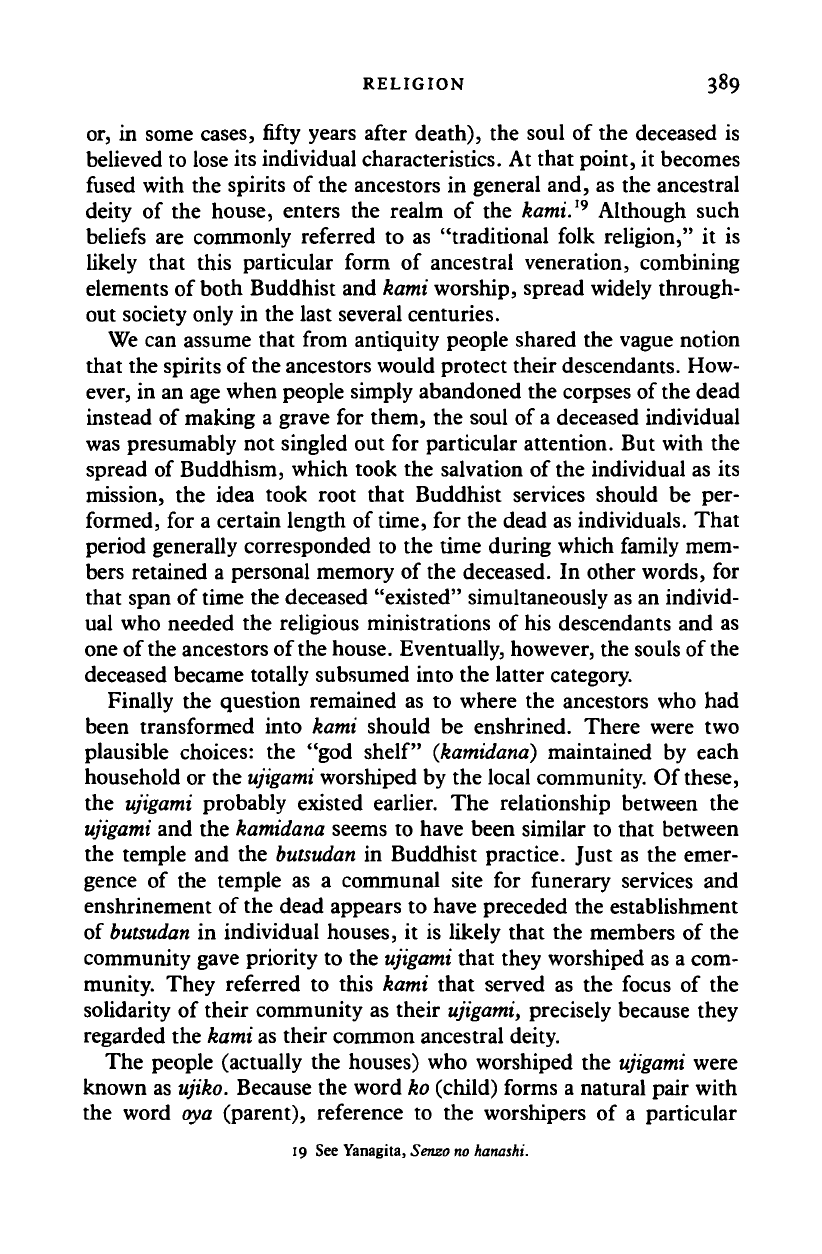
RELIGION 389
or, in some cases, fifty years after death), the soul of the deceased is
believed to lose its individual characteristics. At that point, it becomes
fused with the spirits of the ancestors in general and, as the ancestral
deity of the house, enters the realm of the kami.
19
Although such
beliefs are commonly referred to as "traditional folk religion," it is
likely that this particular form of ancestral veneration, combining
elements of both Buddhist and kami worship, spread widely through-
out society only in the last several centuries.
We can assume that from antiquity people shared the vague notion
that the spirits of the ancestors would protect their descendants. How-
ever, in an age when people simply abandoned the corpses of the dead
instead of making a grave for them, the soul of
a
deceased individual
was presumably not singled out for particular attention. But with the
spread of Buddhism, which took the salvation of the individual as its
mission, the idea took root that Buddhist services should be per-
formed, for a certain length of time, for the dead as individuals. That
period generally corresponded to the time during which family mem-
bers retained a personal memory of the deceased. In other words, for
that span of time the deceased "existed" simultaneously as an individ-
ual who needed the religious ministrations of his descendants and as
one of
the
ancestors of the house. Eventually, however, the souls of the
deceased became totally subsumed into the latter category.
Finally the question remained as to where the ancestors who had
been transformed into kami should be enshrined. There were two
plausible choices: the "god
shelf"
(kamidana) maintained by each
household or the
ujigami
worshiped by the local community. Of these,
the ujigami probably existed earlier. The relationship between the
ujigami
and the
kamidana
seems to have been similar to that between
the temple and the
butsudan
in Buddhist practice. Just as the emer-
gence of the temple as a communal site for funerary services and
enshrinement of the dead appears to have preceded the establishment
of
butsudan
in individual houses, it is likely that the members of the
community gave priority to the
ujigami
that they worshiped as a com-
munity. They referred to this kami that served as the focus of the
solidarity of their community as their
ujigami,
precisely because they
regarded the kami as their common ancestral deity.
The people (actually the houses) who worshiped the
ujigami
were
known as
ujiko.
Because the word ko (child) forms a natural pair with
the word oya (parent), reference to the worshipers of a particular
19 See Yanagita, Senzo
no
hanashi.
Cambridge Histories Online © Cambridge University Press, 2008
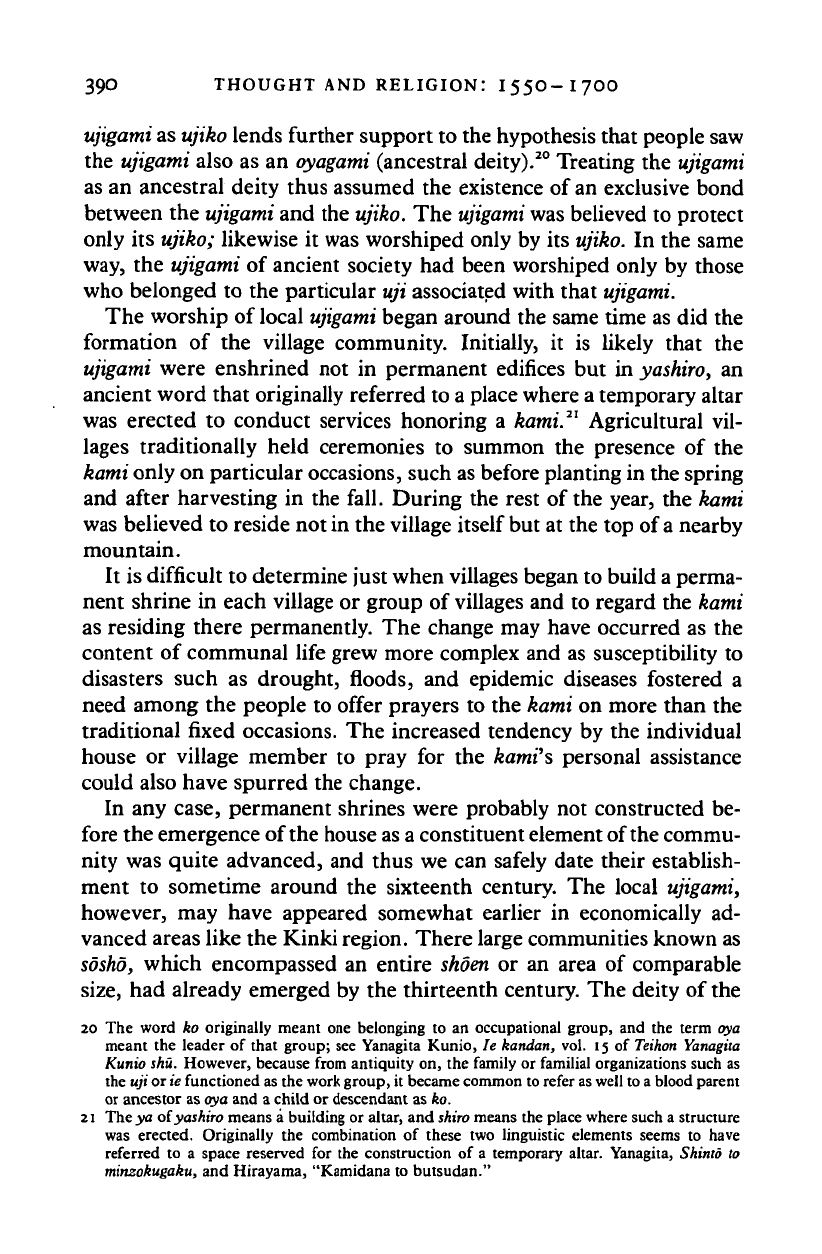
39° THOUGHT AND RELIGION: I55O-I7OO
ujigami
as
ujiko
lends further support to the hypothesis that people saw
the
ujigami
also as an
oyagami
(ancestral deity).
20
Treating the
ujigami
as an ancestral deity thus assumed the existence of an exclusive bond
between the
ujigami
and the
ujiko.
The
ujigami
was believed to protect
only its ujiko; likewise it was worshiped only by its
ujiko.
In the same
way, the
ujigami
of ancient society had been worshiped only by those
who belonged to the particular uji associated with that
ujigami.
The worship of local
ujigami
began around the same time as did the
formation of the village community. Initially, it is likely that the
ujigami
were enshrined not in permanent edifices but in
yashiro,
an
ancient word that originally referred to a place where a temporary altar
was erected to conduct services honoring a kami.
21
Agricultural vil-
lages traditionally held ceremonies to summon the presence of the
kami
only on particular occasions, such as before planting in the spring
and after harvesting in the fall. During the rest of the year, the kami
was believed to reside not in the village itself but at the top of a nearby
mountain.
It is difficult to determine just when villages began to build a perma-
nent shrine in each village or group of villages and to regard the kami
as residing there permanently. The change may have occurred as the
content of communal life grew more complex and as susceptibility to
disasters such as drought, floods, and epidemic diseases fostered a
need among the people to offer prayers to the kami on more than the
traditional fixed occasions. The increased tendency by the individual
house or village member to pray for the kami's personal assistance
could also have spurred the change.
In any case, permanent shrines were probably not constructed be-
fore the emergence of the house
as
a constituent element of the commu-
nity was quite advanced, and thus we can safely date their establish-
ment to sometime around the sixteenth century. The local ujigami,
however, may have appeared somewhat earlier in economically ad-
vanced areas like the Kinki region. There large communities known as
sosho,
which encompassed an entire
shoen
or an area of comparable
size,
had already emerged by the thirteenth century. The deity of the
20 The word ko originally meant one belonging to an occupational group, and the term oya
meant the leader of that group; see Yanagita Kunio, Ie kandan, vol. 15 of
Teihon
Yanagita
Kunio shii. However, because from antiquity on, the family or familial organizations such as
the uji or ie functioned as the work group, it became common to refer as well to a blood parent
or ancestor as oya and a child or descendant as ko.
21 The ya of yashiro means a building or altar, and
shiro
means the place where such a structure
was erected. Originally the combination of these two linguistic elements seems to have
referred to a space reserved for the construction of a temporary altar. Yanagita, Shinto to
minzokugaku, and Hirayama, "Kamidana to butsudan."
Cambridge Histories Online © Cambridge University Press, 2008
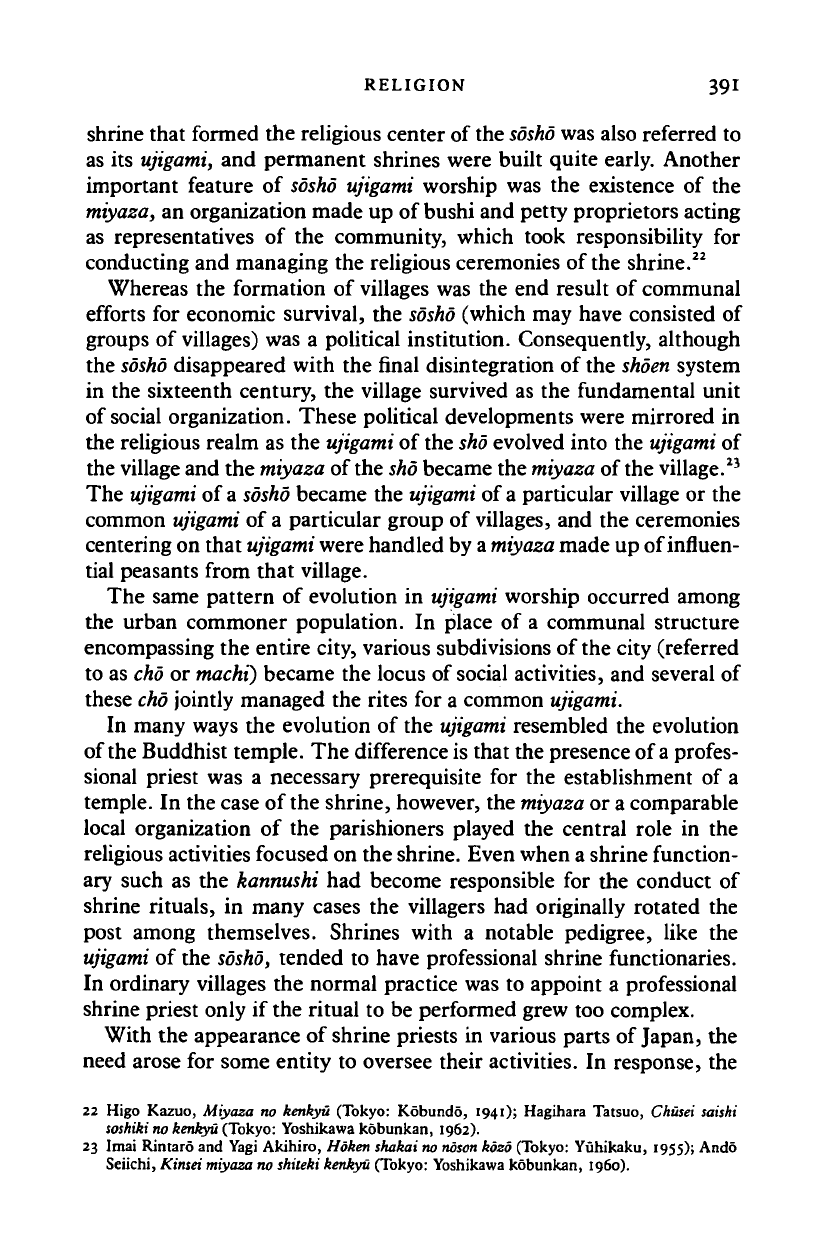
RELIGION 391
shrine that formed the religious center of the
sosho
was also referred to
as its ujigami, and permanent shrines were built quite early. Another
important feature of sosho ujigami worship was the existence of the
miyaza, an organization made up of bushi and petty proprietors acting
as representatives of the community, which took responsibility for
conducting and managing the religious ceremonies of the shrine.
22
Whereas the formation of villages was the end result of communal
efforts for economic survival, the
sosho
(which may have consisted of
groups of villages) was a political institution. Consequently, although
the
sosho
disappeared with the final disintegration of the shoen system
in the sixteenth century, the village survived as the fundamental unit
of social organization. These political developments were mirrored in
the religious realm as the ujigami of the sho evolved into the ujigami of
the village and the miyaza of the
sho
became the miyaza of the village.
23
The ujigami of a
sosho
became the ujigami of a particular village or the
common ujigami of a particular group of villages, and the ceremonies
centering on that ujigami were handled by a miyaza made up of influen-
tial peasants from that village.
The same pattern of evolution in ujigami worship occurred among
the urban commoner population. In place of a communal structure
encompassing the entire city, various subdivisions of the city (referred
to as chb or machi) became the locus of social activities, and several of
these chb jointly managed the rites for a common ujigami.
In many ways the evolution of the ujigami resembled the evolution
of the Buddhist temple. The difference is that the presence of
a
profes-
sional priest was a necessary prerequisite for the establishment of a
temple. In the case of the shrine, however, the miyaza or a comparable
local organization of the parishioners played the central role in the
religious activities focused on the shrine. Even when a shrine function-
ary such as the kannushi had become responsible for the conduct of
shrine rituals, in many cases the villagers had originally rotated the
post among themselves. Shrines with a notable pedigree, like the
ujigami of the sosho, tended to have professional shrine functionaries.
In ordinary villages the normal practice was to appoint a professional
shrine priest only if the ritual to be performed grew too complex.
With the appearance of shrine priests in various parts of Japan, the
need arose for some entity to oversee their activities. In response, the
22 Higo Kazuo, Miyaza no kenkyu (Tokyo: Kobundo, 1941); Hagihara Tatsuo, Chusei saishi
soshiki no kenkyu
(Tokyo: Yoshikawa kobunkan, 1962).
23 Imai Rintaro and Yagi Akihiro, Hoken
shaken
no
noson
kozo (Tokyo: Yuhikaku, 1955); Ando
Seiichi, Kinsei miyaza no shiteki
kenkyu
(Tokyo: Yoshikawa kobunkan, i960).
Cambridge Histories Online © Cambridge University Press, 2008
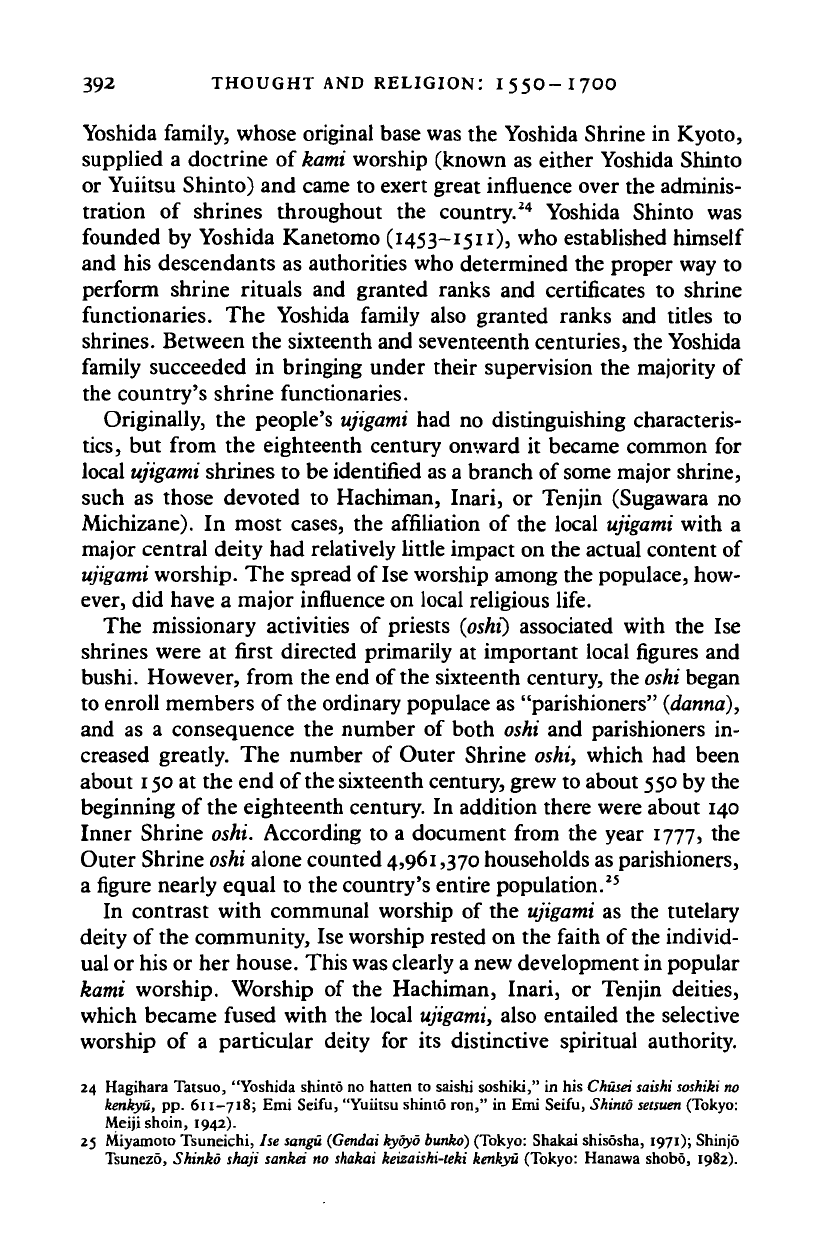
392 THOUGHT AND RELIGION: 1550-I7OO
Yoshida family, whose original base was the Yoshida Shrine in Kyoto,
supplied a doctrine of
kami
worship (known as either Yoshida Shinto
or Yuiitsu Shinto) and came to exert great influence over the adminis-
tration of shrines throughout the country.
24
Yoshida Shinto was
founded by Yoshida Kanetomo (1453-1511), who established himself
and his descendants as authorities who determined the proper way to
perform shrine rituals and granted ranks and certificates to shrine
functionaries. The Yoshida family also granted ranks and titles to
shrines. Between the sixteenth and seventeenth centuries, the Yoshida
family succeeded in bringing under their supervision the majority of
the country's shrine functionaries.
Originally, the people's
ujigami
had no distinguishing characteris-
tics,
but from the eighteenth century onward it became common for
local
ujigami
shrines to be identified as a branch of
some
major shrine,
such as those devoted to Hachiman, Inari, or Tenjin (Sugawara no
Michizane). In most cases, the affiliation of the local
ujigami
with a
major central deity had relatively little impact on the actual content of
ujigami
worship. The spread of
Ise
worship among the populace, how-
ever, did have a major influence on local religious life.
The missionary activities of priests
(oshi)
associated with the Ise
shrines were at first directed primarily at important local figures and
bushi. However, from the end of the sixteenth century, the
oshi
began
to enroll members of the ordinary populace as "parishioners" (danna),
and as a consequence the number of both oshi and parishioners in-
creased greatly. The number of Outer Shrine oshi, which had been
about 150 at the end of the sixteenth century, grew to about 550 by the
beginning of the eighteenth century. In addition there were about 140
Inner Shrine oshi. According to a document from the year 1777, the
Outer Shrine
oshi
alone counted 4,961,370 households as parishioners,
a figure nearly equal to the country's entire population.
25
In contrast with communal worship of the
ujigami
as the tutelary
deity of the community, Ise worship rested on the faith of the individ-
ual or his or her house. This was clearly a new development in popular
kami worship. Worship of the Hachiman, Inari, or Tenjin deities,
which became fused with the local
ujigami,
also entailed the selective
worship of a particular deity for its distinctive spiritual authority.
24 Hagihara Tatsuo, "Yoshida shinto no hatten to saishi soshiki," in his Chusei
saishi soshiki
no
kenkyu, pp. 611-718; Emi Seifu, "Yuiitsu shinto ron," in Emi Seifu, Shinto
setsuen
(Tokyo:
Meiji shoin, 1942).
25 Miyamoto Tsuneichi, Ise sangu (Gendai kyoyo
bunko)
(Tokyo: Shakai shisosha, 1971); Shinjo
Tsunezo, Shinko shaji sankei no shakai keizaishi-teki kenkyu (Tokyo: Hanawa shobo, 1982).
Cambridge Histories Online © Cambridge University Press, 2008

RELIGION 393
Notably it was from the sixteenth century onward that faith in a
particular Hachiman, Inari, or Tenjin shrine, apart from one's
ujigami,
spread among the general populace. The parallel existence of two
types of
kami
worship, one at the level of the community and the other
at the level of the house or the individual, became a new feature of the
religious life of this period, and Ise worship was the most representa-
tive example of the latter type of
kami
worship.
From the eighteenth century it became common for households
to
set
up
kamidana
(god shelves) and to place in them talismans from their
local
ujigami
and from the Ise Shrine. The kami worship conducted at
the level of the individual house thus retained
a
magical component, as
did individual worship of
kami.
However, kami worship sustained by
the individual's growing sense of self-awareness also came to acquire a
rational, ethical orientation among
some
worshipers.
This development
may
be
seen in the appearance of religious teachings that stressed rectify-
ing oneself in order to conform to the kami's desire.
A key example of such teachings is the "Oracle of the Three
Shrines" (Sanja takusen), which is believed to have been formulated
some time in the fifteenth century.
26
The "Oracle of the Three
Shrines" consisted of
a
piece of paper on which the names of the Ise,
Hachiman, and Kasuga shrines were written. Below that was recorded
the claim that the deity of each of these shrines taught the virtues of
complete sincerity (shojiki), purity (shojo), and benevolence (jihi).
From the sixteenth century onward this oracle was widely circulated,
and it was common for ordinary people to mount a copy of it on a
scroll that was placed in the alcove of their houses. This form of
kami
worship could be a denial of the efficacy of magical prayers and rituals.
The popularity of the saying "If one's heart conforms to the way of
complete sincerity
(makoto),
even if one offers no prayers, the kami
will provide protection" may have reflected a trend away from
magic.
27
An example of yet another new form of kami worship that took
shape in this period was the practice of enshrining human beings as
kami. A key date in the development of this practice was the enshrine-
ment in 1599 of Toyotomi Hideyoshi, who had died the previous year,
as Toyokuni daimyojin, at a shrine built in his honor in Kyoto. Before
this time, historical figures had become the object of worship at cer-
26 Watanabe Kunio, "Sanja takusen no shinko," in Watanabe Kunio, Shinto shiso to sono
kenkyusha
tachi (Tokyo: Wataki, 1957).
27 In his Yottuki, written in 1650, Watarai Nobuyoshi argued that despite the prevalence of this
formulation, it still was necessary to offer prayers to the kami.
Cambridge Histories Online © Cambridge University Press, 2008
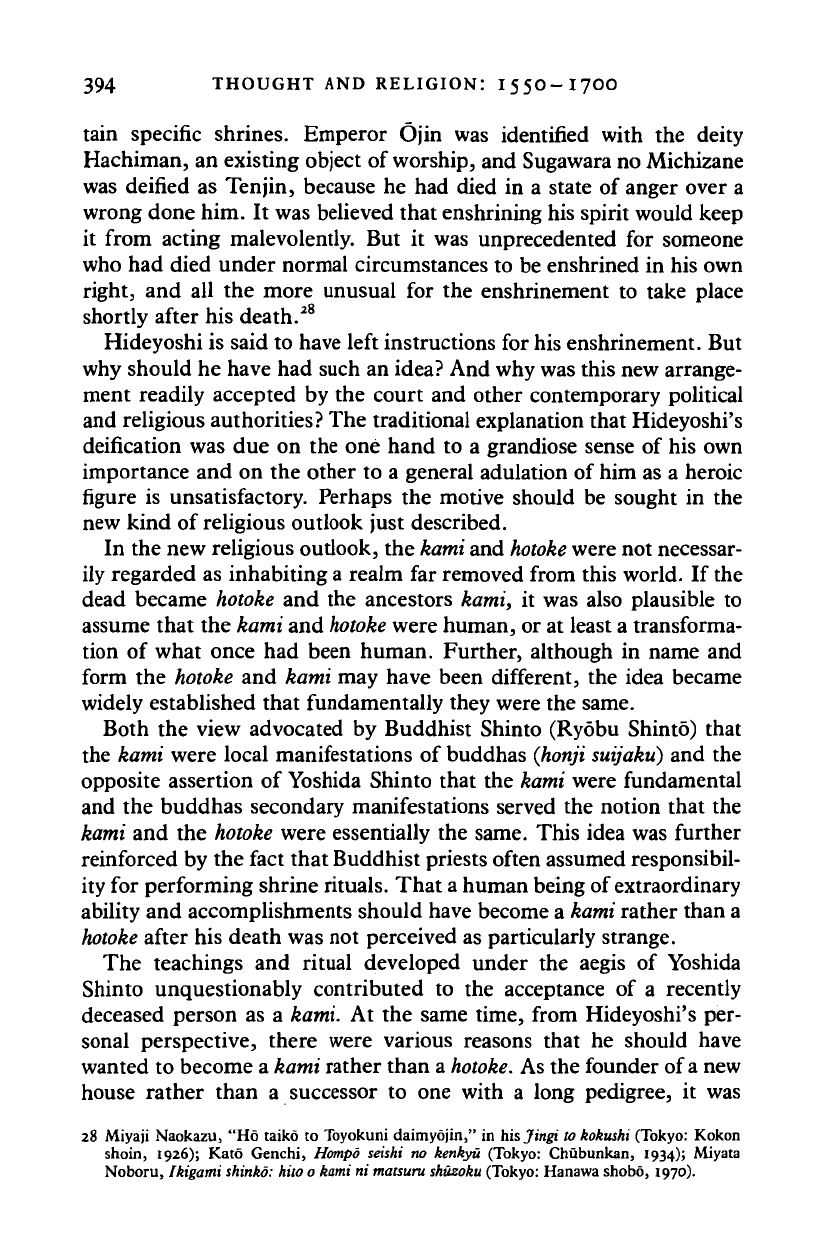
394 THOUGHT AND RELIGION: I55O-I7OO
tain specific shrines. Emperor Ojin was identified with the deity
Hachiman, an existing object of worship, and Sugawara no Michizane
was deified as Tenjin, because he had died in a state of anger over a
wrong done him. It was believed that enshrining his spirit would keep
it from acting malevolently. But it was unprecedented for someone
who had died under normal circumstances to be enshrined in his own
right, and all the more unusual for the enshrinement to take place
shortly after his death.
28
Hideyoshi is said to have left instructions for his enshrinement. But
why should he have had such an idea? And why was this new arrange-
ment readily accepted by the court and other contemporary political
and religious authorities? The traditional explanation that Hideyoshi's
deification was due on the one hand to a grandiose sense of his own
importance and on the other to a general adulation of him as a heroic
figure is unsatisfactory. Perhaps the motive should be sought in the
new kind of religious outlook just described.
In the new religious outlook, the
kami
and
hotoke
were not necessar-
ily regarded as inhabiting
a
realm far removed from this world. If the
dead became hotoke and the ancestors kami, it was also plausible to
assume that the kami and
hotoke
were human, or at least a transforma-
tion of what once had been human. Further, although in name and
form the
hotoke
and kami may have been different, the idea became
widely established that fundamentally they were the same.
Both the view advocated by Buddhist Shinto (Ryobu Shinto) that
the kami were local manifestations of buddhas
(honji suijaku)
and the
opposite assertion of Yoshida Shinto that the kami were fundamental
and the buddhas secondary manifestations served the notion that the
kami and the
hotoke
were essentially the same. This idea was further
reinforced by the fact that Buddhist priests often assumed responsibil-
ity for performing shrine rituals. That a human being of extraordinary
ability and accomplishments should have become a kami rather than a
hotoke
after his death was not perceived as particularly strange.
The teachings and ritual developed under the aegis of Yoshida
Shinto unquestionably contributed to the acceptance of a recently
deceased person as a kami. At the same time, from Hideyoshi's per-
sonal perspective, there were various reasons that he should have
wanted to become a kami rather than a
hotoke.
As the founder of a new
house rather than a successor to one with a long pedigree, it was
28 Miyaji Naokazu, "Ho taiko to Toyokuni daimyojin," in his Jingi to kokushi (Tokyo: Kokon
shoin, 1926); Kato Genchi, Hompo seishi no kenkyu (Tokyo: Chubunkan, 1934); Miyata
Noboru, Ikigami shinko: hito 0 kami ni matsuru shuzoku (Tokyo: Hanawa shobo, 1970).
Cambridge Histories Online © Cambridge University Press, 2008
